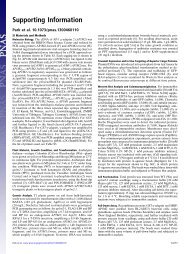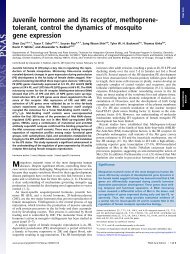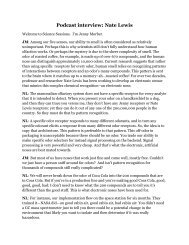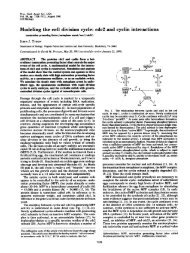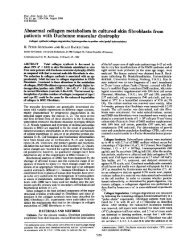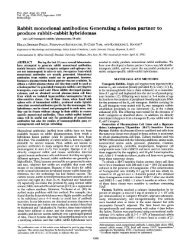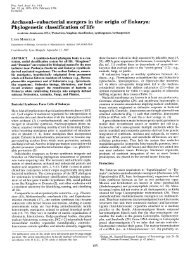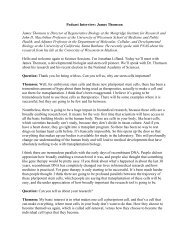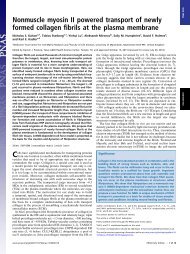Diffusion frequency factors in some simple examples of transition ...
Diffusion frequency factors in some simple examples of transition ...
Diffusion frequency factors in some simple examples of transition ...
You also want an ePaper? Increase the reach of your titles
YUMPU automatically turns print PDFs into web optimized ePapers that Google loves.
Proc. Nat. Acad. Sci. USA<br />
Vol 73, No. 3, pp. 679-683, March 1976<br />
Chemistry<br />
<strong>Diffusion</strong> <strong>frequency</strong> <strong>factors</strong> <strong>in</strong> <strong>some</strong> <strong>simple</strong> <strong>examples</strong> <strong>of</strong> <strong>transition</strong>state<br />
rate theory*<br />
(Eyr<strong>in</strong>g rate theory/dynamics versus diffusion)<br />
TERRELL L. HILL<br />
Laboratory <strong>of</strong> Molecular Biology, National Institute <strong>of</strong> Arthritis, Metabolism, and Digestive Diseases, National Institutes <strong>of</strong> Health, Bethesda, Maryland 20014<br />
Contributed by Terrell L. Hill, January 8, 1976<br />
ABSTRACT In the Eyr<strong>in</strong>g rate theory, the rate constant<br />
is expressed as a product <strong>of</strong> a <strong>frequency</strong> factor (kT/h) and a<br />
quotient <strong>of</strong> partition functions. Cont<strong>in</strong>u<strong>in</strong>g an earlier paper,<br />
it is shown here by means <strong>of</strong> <strong>simple</strong> <strong>examples</strong> that the Eyr<strong>in</strong>g<br />
formalism may be extended to <strong>in</strong>clude diffusion-controlled<br />
processes if a new <strong>frequency</strong> factor, D/RA, is substituted for<br />
kT/h, where D = diffusion coefficient, A = thermal de Broglie<br />
wavelength, and R = a characteristic distance that depends<br />
on the particular case. The Eyr<strong>in</strong>g formalism is also<br />
applicable <strong>in</strong> hybrid cases, <strong>in</strong>termediate between diffusion<br />
(D/RA) and dynamics (kT/h). Because these modified <strong>frequency</strong><br />
<strong>factors</strong> are not "universal" (as kT/h is), their ma<strong>in</strong><br />
use (other than conceptual) would appear to be <strong>in</strong> cases <strong>in</strong><br />
which one considers a <strong>simple</strong> model (with calculable <strong>frequency</strong><br />
factor) together with a related more complicated<br />
model. In the latter case, as an approximation, one would<br />
comb<strong>in</strong>e the "<strong>simple</strong>" <strong>frequency</strong> factor with the "complicated"<br />
quotient <strong>of</strong> partition unctions <strong>in</strong> order to obta<strong>in</strong> the desired<br />
rate constant. Examples are given.<br />
In the Eyr<strong>in</strong>g rate theory, the rate constant is expressed as a<br />
product <strong>of</strong> a <strong>frequency</strong> factor (f.f.) kT/h and a quotient <strong>of</strong><br />
partition functions (p.f.s), all relative to the same zero <strong>of</strong> energy<br />
(1). It was shown <strong>in</strong> an earlier paper (2) that the Eyr<strong>in</strong>g<br />
formalism can be extended to diffusion-controlled ligandmacromolecule<br />
association <strong>in</strong> solution by substitution <strong>of</strong> a<br />
new f.f., D/RA, <strong>in</strong> place <strong>of</strong> the usual dynamical factor<br />
kT/h. The primary object <strong>in</strong> this paper is to supplement this<br />
earlier discussion with additional elementary <strong>examples</strong> <strong>in</strong>volv<strong>in</strong>g<br />
diffusion. For completeness, we consider the correspond<strong>in</strong>g<br />
dynamical cases as well. Classical mechanics is<br />
used throughout. The paper <strong>of</strong> Chandrasekar (3), follow<strong>in</strong>g<br />
Kramers (4), provides the necessary background and much<br />
<strong>of</strong> the notation used.<br />
ONE-DIMENSIONAL EXAMPLES<br />
<strong>Diffusion</strong> Case. We consider the steady rate <strong>of</strong> <strong>transition</strong>s<br />
<strong>in</strong> the direction A -- B for the case shown <strong>in</strong> Fig. 1 (3, 4),<br />
where w = potential <strong>of</strong> mean force (1, 2). From the Smoluchowski<br />
equation, Eq. 312 <strong>of</strong> ref. 3,<br />
dc = j c-D -+ dw\<br />
at ax' ax kT dx'<br />
we obta<strong>in</strong> for the steady A -- B flux j (per unit area), as <strong>in</strong><br />
Eq. 472 <strong>of</strong> ref. 3,<br />
= Dc 4e"- /IR [11<br />
where<br />
R fJ e-f(X/kTdX, [2]<br />
Abbreviations: p.f., partition function; f.f., <strong>frequency</strong> factor.<br />
*<br />
This paper is dedicated to Henry Eyr<strong>in</strong>g as a personal "supplement"<br />
to the recent volume [(1971) Advances <strong>in</strong> Chemical Physics,<br />
eds. Prigog<strong>in</strong>e, I. & Rice, S. (Wiley-Interscience, New York),<br />
Vol. 211 published <strong>in</strong> his honor on the occasion <strong>of</strong> his seventieth<br />
birthday.<br />
D = diffusion coefficient, CA = local concentration at x =<br />
XA, and f(X) - w w-w(X) <strong>in</strong> the neighborhood <strong>of</strong> x = xc.<br />
The total number <strong>of</strong> particles (per unit area) <strong>in</strong> state A,<br />
treated as at equilibrium, is nA = CAqAA, where qA = equilibrium<br />
one-dimensional p.f. and A = h/(27rmkT)1/2 = thermal<br />
deBroglie wavelength. This follows from the fact that<br />
qAA is the so-called configuration <strong>in</strong>tegral (1) for state A.<br />
For example (1, 3), qA = kT/hvA (classical harmonic oscillator).<br />
The (first-order) rate constant for A A B is then (compare<br />
Eq. 473 <strong>of</strong> ref. 3)<br />
a = jI/nA = (DIRA)(e-w*1kT/qA) [3]<br />
But s<strong>in</strong>ce, for this <strong>simple</strong> model, q* = e-w*/kT <strong>in</strong> the Eyr<strong>in</strong>g<br />
rate theory (1), we see aga<strong>in</strong> (2) that replacement <strong>of</strong> the f.f.<br />
kT/h by a new factor D/RA produces the proper rate constant<br />
<strong>in</strong> the diffusion case. Here, R is def<strong>in</strong>ed by Eq. 2. If we<br />
expand f(X) about X = 0 and reta<strong>in</strong> only the quadratic term<br />
Wc2mX2/2, which def<strong>in</strong>es wc, we f<strong>in</strong>d R = (2AkT/<br />
If the barrier <strong>in</strong> w(X) has<br />
Wc2m)1/2, or Wc2mR2/2 = 7rkT.<br />
the hypothetical shape shown <strong>in</strong> the <strong>in</strong>set <strong>of</strong> Fig. 1, then R =<br />
1. In either <strong>of</strong> these cases, for a wide barrier, i.e., R x, o we<br />
have a D/RA - - 0.<br />
As already po<strong>in</strong>ted out (2), D/RA is not a "universal" f.f.<br />
as kT/h is <strong>in</strong> the (generally <strong>some</strong>what approximate) Eyr<strong>in</strong>g<br />
theory. Rather, D/RA depends on the special case. Despite<br />
this, there are at least three advantages to rewrit<strong>in</strong>g diffusion<br />
rate constants <strong>in</strong> the modified Eyr<strong>in</strong>g form, i.e., (DI<br />
RA) X (p.f. quotient): (a) the considerable conceptual and<br />
<strong>in</strong>tuitive benefits deriv<strong>in</strong>g from the Eyr<strong>in</strong>g formalism are<br />
thereby extended to a new class <strong>of</strong> rate processes; (b) it may<br />
be possible to estimate R and hence to calculate the diffusion<br />
rate constant (with the aid <strong>of</strong> the appropriate p.f.s) <strong>in</strong> <strong>some</strong><br />
cases <strong>in</strong> which the ab <strong>in</strong>itio diffusion problem is too difficult<br />
to solve; and (c) R may be found for a diffusion problem <strong>in</strong><br />
a relatively small number <strong>of</strong> coord<strong>in</strong>ates (or the diffusion<br />
problem might be simplified <strong>in</strong> <strong>some</strong> other way) and then<br />
this R is reta<strong>in</strong>ed, as an approximation, when more coord<strong>in</strong>ates<br />
are added to the model via the p.f.s.<br />
An example <strong>of</strong> (c), above, has already been given (2):<br />
translation A translation + rotation <strong>in</strong> the b<strong>in</strong>d<strong>in</strong>g <strong>of</strong> spherical<br />
ligands. Another example is <strong>in</strong> the paragraph follow<strong>in</strong>g<br />
Eq. 13 <strong>of</strong> ref. 2: R for the field-free b<strong>in</strong>d<strong>in</strong>g case was reta<strong>in</strong>ed,<br />
as an approximation, for the case with an external<br />
field (this approximation is not used below, <strong>in</strong> Eq. 24). As a<br />
third example <strong>of</strong> (c), let us extend, formally, the one-dimensional<br />
result <strong>in</strong> Eqs. 2 and 3 to three dimensions by allow<strong>in</strong>g<br />
yz-vibrational motion <strong>of</strong> the particle normal to the x-axis<br />
(the "reaction coord<strong>in</strong>ate"), both <strong>in</strong> the <strong>in</strong>itial state and <strong>in</strong><br />
the <strong>transition</strong> state. Then<br />
a= (DIRA)(q$ ,ze -u-*T/qAqA z)<br />
[4]<br />
where q*YZ and qAyz are the new vibrational p.f.s.<br />
679
680 Chemistry: Hill<br />
Proc. Nat. Acad. Sci. USA 73 (1976)<br />
w<br />
w=w* -f(X) s .w )) kT<br />
w = 0 * - - - - -,<br />
XA Xc XB<br />
0 X = x -Xc<br />
FIG. 1. Schematic. One-dimensional potential <strong>of</strong> mean force for study <strong>of</strong> <strong>transition</strong> A - B across barrier w* >> kT at xc. Inset shows<br />
hypothetical barrier with flat top and steep edges.<br />
General Relations. When (<br />
=<br />
kT/mD is not large compared<br />
to 2wc, we need a solution <strong>of</strong> the (steady-state) Kramers<br />
equation (Eq. 477, ref. 3)<br />
wa + Kow =<br />
OU aw + COW + qa0W<br />
ax au auau<br />
where W(X,u) = probability density <strong>in</strong> X and u (velocity), q<br />
= kTf3/m, and K = -m-1dw/dX. We write<br />
W(X,u) = CF(X,u)e-mu2/2kTee-w/kT [6]<br />
where F 1 at equilibrium. Then (Eq. 485, ref. 3)<br />
OF aF a2F aF<br />
Ua + K a= - AlU u [7]<br />
For the solution <strong>of</strong> Eq. 7 around the peak <strong>in</strong> w, the boundary<br />
conditions are F = 1 for X - -c and F = 0 for X<br />
+o. The required steady flux j across X = 0 (or, <strong>in</strong>deed,<br />
across any other value <strong>of</strong> X) is<br />
[5]<br />
j= f W(X=o,u)udu. [8]<br />
In the diffusion case 3>> 2wc and f = wc2mX2/2, we can<br />
obta<strong>in</strong> j from§ Eqs. 6 through 8 (3), compare the result with<br />
Eq. 1, and thus evaluate the normalization constant <strong>in</strong> W.<br />
One f<strong>in</strong>ds C = cA(m/27rkT)'/2. Thus, the normalization is<br />
such that, at equilibrium, fWdu = cAe-w/kT = local concentration.<br />
Incidentally, <strong>in</strong> the diffusion case, one can show<br />
from§ f Wdu at X = 0 (and verify from the Smoluchowski<br />
equation approach) that the local concentration at the <strong>transition</strong><br />
state <strong>in</strong> steady flow is one-half the equilibrium value,<br />
cAe/k<br />
c -w*IkT<br />
Dynamical Case. Here (3 = 0 and w = potential energy.<br />
Only the left-hand sides <strong>of</strong> Eqs. 5 and 7 rema<strong>in</strong> (Liouville's<br />
equation). The solution, for our boundary conditions, is F =<br />
1 or F = 0 with a step between these values along the curve<br />
u = [2f(X)/m]'/2 <strong>in</strong> the X,u-plane. If f = WC2mX2/2, this<br />
curve is the straight l<strong>in</strong>e u = wcX (Q = 0 <strong>in</strong> the notation <strong>of</strong><br />
ref. 3). On X = 0 (Eq. 8), where f = 0, F = 1 for u > 0 and<br />
§ For this purpose, it is helpful to use (at X = 0) F(u) = ('k) + (Wc2/<br />
27rfq)1/2u +.--.<br />
F = 0 for u 0 and F = 0, u 1.5.<br />
Thus, SYE and 5SD are merely two limit<strong>in</strong>g forms <strong>of</strong> f.f.<br />
(though no doubt the most important). Indeed, a further<br />
generalization <strong>of</strong> considerable physical <strong>in</strong>terest (which is<br />
be<strong>in</strong>g <strong>in</strong>vestigated) follows on use <strong>of</strong> (3 = (3(X) <strong>in</strong> Eq. 7 <strong>in</strong>stead<br />
<strong>of</strong> (3 = constant. For example, ( is a step function: (3 =<br />
(3- for X < 0 and (3 (3+ for X > 0 (see Discussion).<br />
Of course a generalized 5' (i.e., one other than 9rE or 9'D)<br />
can also be used <strong>in</strong> <strong>examples</strong> <strong>of</strong> type (c) above (see Eq. 29,<br />
below).
0.8<br />
0.6<br />
0.4<br />
0.2<br />
X<br />
Chemistry:<br />
\1/2s<br />
Hill<br />
\ \<br />
' \ ----<br />
I-s ".<br />
I...<br />
0 1 2 3 4<br />
s *l/2wc<br />
-<br />
FIG. 2. Solid curve: /9E as a function <strong>of</strong> s = :X2wc (Eq. 12).<br />
/E = 1 is the limit<strong>in</strong>g value (O = kT/h) at s = 0; the <strong>in</strong>itial slope<br />
is -1. For large s, 9/E- 1/2s (i.e., 9 -. D = D/RA).<br />
F<strong>in</strong>ally, we note that, <strong>in</strong> the <strong>in</strong>termediate case, we also<br />
have (M)cAe-w*/kT for the local concentration at X = 0,<br />
s<strong>in</strong>ce F(u) on X = 0 is equal to i plus an odd function <strong>of</strong> u.<br />
THREE-DIMENSIONAL EXAMPLES (WITH<br />
SPHERICAL SYMMETRY)<br />
Bimolecular Association <strong>in</strong> Solution. We have already<br />
considered (2) the case <strong>in</strong> which freely diffus<strong>in</strong>g po<strong>in</strong>t (ligand)<br />
particles may be bound at sites on relatively large adsorbent<br />
molecules once a ligand molecule crosses a hemispherical<br />
shell <strong>of</strong> radius rc (Fig. 3, dashed l<strong>in</strong>e) about any<br />
site. It was found that, <strong>in</strong> the f.f. D/RA for this case, R = rc<br />
(Eq. 9, ref. 2).<br />
The above model can be modified easily to treat a bimolecular<br />
reaction <strong>in</strong> which a molecule <strong>of</strong> species 1 (ml, Dl)<br />
comb<strong>in</strong>es with another <strong>of</strong> species 2 (m2, D2) to form a bimolecular<br />
complex whenever a mutual approach is made<br />
with<strong>in</strong> a critical distance rc. The second-order rate constant<br />
a' for this process is found to be 47r(DI + D2)rc (Eq. 447,<br />
ref. 3). The p.f.s <strong>in</strong>volved are (ref. 1, p. 155)<br />
q1 = V/A13, q2 = V/A23, q* = (V/A123)(27rkT/h2)4rrc2<br />
[14]<br />
where ml + M2 appears <strong>in</strong> A12 and 1A = Mlm2/(Ml + m2).<br />
Proc. Nat. Acad. Sci. USA 73 (1976) 681<br />
If, for this case, <strong>in</strong> view <strong>of</strong> the above paragraph, we write<br />
the f.f. <strong>in</strong> the form (D1 + D2)/rcX, that is,<br />
'= 47r(D, + D2)rc=<br />
[(D1 + D2)/rcA](qt/V)/(q1/V)(q2/V) [15]<br />
then we f<strong>in</strong>d, as one might expect, that X = h/(27rgukT)l/2.<br />
If, say, species 2 is very large (M2 >> ml, D2
6.82 Chemistry: Hill<br />
If w(r) has the simplified shape shown <strong>in</strong> <strong>in</strong>set (a) <strong>of</strong> Fig.<br />
3, Eq. 18 gives R = rc, as found for the reverse processl (2).<br />
If w(r) appears as <strong>in</strong> <strong>in</strong>set (b) <strong>of</strong> Fig. 3, we f<strong>in</strong>d R = rcl/(rc<br />
+ 1).<br />
A more realistic case: if w(r) = w* for r > rc (dashed l<strong>in</strong>e<br />
<strong>in</strong> Fig. 3) and f = wC2mX2/2 for r < rc, then Eq. 18 gives R<br />
rc + Ar, where Ar = (7rkT/2oc2m)'/2. The curvature<br />
<strong>of</strong> f(r) for r < rc must be such that WCc2mrc2/2 = O(wt*) >><br />
kT. Therefore, rc >> Ar and R rc [i.e., essentially as <strong>in</strong><br />
the <strong>in</strong>set (a) case].<br />
If, <strong>in</strong> Fig. 3, w* - WB >> kT and f = WC2mX2/2 on both<br />
sides <strong>of</strong> r = rc (X = 0), then we get R n 2Ar, as already<br />
found <strong>in</strong> the one-dimensional problem. Hence, the rate constant<br />
for escape is much larger here than <strong>in</strong> the preced<strong>in</strong>g<br />
paragraph (R rc), the ratio be<strong>in</strong>g rc/2Ar.<br />
-<br />
S<strong>in</strong>ce we have now considered the diffusion-escape problem<br />
<strong>in</strong> both one (Eq. 3) and three (Eq. 20) dimensions, we<br />
can use the results to test, <strong>in</strong> a specific case, the approximation<br />
suggested <strong>in</strong> Eq. 4. If we had started with Eq. 3 (for<br />
present purposes, let us use RI to denote the R given by Eq.<br />
2) and then <strong>in</strong>troduced q yz = 27rrc2/A2 and qA- qAqAyz<br />
<strong>in</strong>to Eq. 4 <strong>in</strong> order to extend Eq. 3 to three dimensions, we<br />
would have obta<strong>in</strong>ed Eq. 20 but with R1 <strong>in</strong> place <strong>of</strong> the correct<br />
R3 (def<strong>in</strong>ed by Eq. 18). The approximation R1 - Rs is<br />
satisfactory to the extent that one is justified <strong>in</strong> plac<strong>in</strong>g r-2<br />
<strong>in</strong> Eq. 18 <strong>in</strong> front <strong>of</strong> the <strong>in</strong>tegral sign, as rc-2. Thus, the<br />
sharper the peak <strong>in</strong> w(r), the better the approximation R1 _<br />
R3. Indeed, we have already noted <strong>in</strong> the preced<strong>in</strong>g paragraph<br />
that, for the case f X2 (IXI > 0), R1 = 2Ar and R3<br />
2Ar.<br />
F<strong>in</strong>ally, the concentration at r = rc (<strong>transition</strong> state) deserves<br />
comment. If we take 1 = rA and 2 = rc <strong>in</strong> Eq. 16, we<br />
f<strong>in</strong>d<br />
= ce [1 - ( [22]<br />
where the <strong>in</strong>tegrands are the same as <strong>in</strong> Eq. 18. Of course, if<br />
there were equilibrium between the <strong>transition</strong> state and<br />
state A, [ ] 1. In the "dashed l<strong>in</strong>e" case (Fig. 3) above, the<br />
ratio f/f Ar/rc is small and [ ] 1. But <strong>in</strong> the next example<br />
(f - X2 for Xi > 0), cc is one-half <strong>of</strong> the equilibrium<br />
value cAe-w*/kT (as <strong>in</strong> the one-dimensional problem). For<br />
<strong>in</strong>sets (a) and (b) <strong>of</strong> Fig. 3, cc has the equilibrium value.<br />
We turn now to the <strong>in</strong>verse (b<strong>in</strong>d<strong>in</strong>g) process <strong>in</strong> the diffusion<br />
case. Fig. 3 and Eq. 16 still apply except that now c<br />
= 0 <strong>in</strong> state A and c = CB <strong>in</strong> state B (rB oo), If we choose<br />
1 = rA and 2 = rB <strong>in</strong> Eq. 16, we obta<strong>in</strong> for the second-order<br />
rate constant for b<strong>in</strong>d<strong>in</strong>g ligand to macromolecule (2),<br />
a' = -JICB = 2rDrc2e-(u- WB)/kT/R [23]<br />
where R is aga<strong>in</strong> given by Eq. 18. The special cases <strong>of</strong> Fig. 3,<br />
above, lead<strong>in</strong>g to various R values, apply here as well. For<br />
example, for <strong>in</strong>set (a), a' = 27rDrc as <strong>in</strong> ref. 2, Eq. 8.<br />
As already mentionedl, the f.f. D/RA <strong>in</strong> Eq. 20 must also<br />
be <strong>in</strong>volved here for the <strong>in</strong>verse process. But to verify this, a<br />
little more care is required with the partition functions (because<br />
the <strong>in</strong>verse process is bimolecular). Us<strong>in</strong>g qA and q2$<br />
as def<strong>in</strong>ed above, we now write (2) p.f.A = qA3qV, p.f.$ =<br />
q2tqV, qo = qV, and qB = (V/A3)e wB/kT, where qo is the<br />
p.f. <strong>of</strong> a macromolecule with an empty b<strong>in</strong>d<strong>in</strong>g site. Then<br />
we f<strong>in</strong>d, as expected, that<br />
a' = (D/RA)(p-f.*/V)/(q0/V)(qB/V) [24]<br />
The f.f.s must necessarily be the same <strong>in</strong> the expressions for the<br />
two <strong>in</strong>verse rate constants, <strong>in</strong> view <strong>of</strong> the p.f. ratios <strong>in</strong>volved and<br />
their relation to the equilibrium constant (1).<br />
Proc. Nat. Acad. Sci. USA 73 (1976)<br />
agrees with Eq. 23. The equilibrium constant for b<strong>in</strong>d<strong>in</strong>g is<br />
(compare Eq. 5, ref. 2)<br />
K = a'/a = (pf-A/V)/(qO/V)(qB/V)<br />
=<br />
qA3A3ewRlkT. [25]<br />
To f<strong>in</strong>d cc, we choose 1 = rA and 2 = rc <strong>in</strong> Eq. 16 with<br />
the result<br />
Cc = cBe-(u- WB)/kT (f/ ) [26]<br />
In a certa<strong>in</strong> sense, this is the <strong>in</strong>verse <strong>of</strong> Eq. 22. For <strong>in</strong>sets (a)<br />
and (b), Fig. 3, cc = 0. In the "dashed l<strong>in</strong>e" case, cc n<br />
CBAr/rC, which is small. In the f X2 aIXI > 0) case, cc is<br />
one-half <strong>of</strong> the equilibrium value.<br />
_<br />
In the conventional treatment <strong>of</strong> this b<strong>in</strong>d<strong>in</strong>g problem,<br />
us<strong>in</strong>g a differential equation <strong>in</strong> c, the boundary condition c<br />
= 0 ("absorption") on the surface r = rc is used. The above<br />
paragraph shows that this is usually safe (the cotrect condition<br />
is CA = 0); however, <strong>in</strong> the f<br />
- X2 case, c £ 0 is justified<br />
only if w* - WB >> kT.<br />
Dynamical Case. We consider the rate <strong>of</strong> escape, <strong>in</strong> Fig.<br />
3, when 13 = 0. We are concerned with the three-dimensional<br />
Liouville equation with potential energy w a function <strong>of</strong> r<br />
only. But because <strong>of</strong> the condition rc >> Ar already mentioned<br />
<strong>in</strong> relation to this figure, the spherical surface can be<br />
treated as planar to a good approximation. Hence the discussion<br />
<strong>of</strong> the one-dimensional dynamical case, above, applies<br />
here with very little change. We obta<strong>in</strong> Eq. 9 for jr, as before,<br />
for any shape f(r). The total flux across the surface r =<br />
rc is J = 2lrrC2j,. The number <strong>of</strong> molecules <strong>in</strong> state A is nA<br />
= cAqA3A3. Thus we are led to<br />
a = J/nA = (kT/h)(q2t/qu), [27]<br />
<strong>in</strong> agreement with Eyr<strong>in</strong>g's formulation (q2* is given by Eq.<br />
21). If we use Eq. 19 for qA3,<br />
a = VA(rc /rA)e [28]<br />
Intermediate Case. For f = WC2mX2/2 and arbitrary f3/<br />
2wc, aga<strong>in</strong> because <strong>of</strong> the condition rc >> Ar we have essentially<br />
the one-dimensional differential equation, Eq. 5, to a<br />
good approximation. The one-dimensional solution (3, 4)<br />
can, therefore, be used but with J = 27rrC2j and nA =<br />
cAqA3A3. Hence<br />
al<br />
[29]<br />
= 3 (q2*/qA3)<br />
where 5f is given by Eqs. 12 and 13. Note that this follows<br />
from Eq. 11 simply by modify<strong>in</strong>g the p.f. quotient. The<br />
"exact" agreement <strong>in</strong> f.f. <strong>in</strong> the two cases is <strong>of</strong> course simply<br />
a consequence <strong>of</strong> the approximation we have made <strong>in</strong> handl<strong>in</strong>g<br />
the three-dimensional problem.<br />
DISCUSSION<br />
(a) The form D/RA for the diffusion f.f. is fairly obvious<br />
from an essentially dimensional po<strong>in</strong>t <strong>of</strong> view. In the first<br />
place, j D so we must have f.f. D. Then D = (r2)/6r or<br />
(x2)/2r, where r-1 is the <strong>frequency</strong> <strong>of</strong> steps <strong>in</strong> a three-dimensional<br />
random walk, and (r2) is the mean square displacement<br />
per step (3). S<strong>in</strong>ce f.f. and r-1 are both frequencies,<br />
D <strong>in</strong> f.f. must be divided by a quantity with dimensions<br />
(length)2. That one <strong>of</strong> these lengths should be A, leav<strong>in</strong>g the<br />
other (R) to characterize the <strong>transition</strong> state <strong>in</strong> <strong>some</strong> way,<br />
can be understood as follows. We are really forc<strong>in</strong>g a classi-
Chemistry:<br />
Hill<br />
Proc. Nat. Acad. Sci. USA 73 (1976) 683<br />
cal (diffusion) rate constant <strong>in</strong>to the form f.f. X p.f. quotient.<br />
S<strong>in</strong>ce any "classical" one-dimensional p.f. - h-1 (1), and<br />
s<strong>in</strong>ce, by def<strong>in</strong>ition, q* <strong>in</strong> the numerator <strong>of</strong> p.f. quotient always<br />
has one degree <strong>of</strong> freedom less than the denom<strong>in</strong>ator,<br />
it is necessary for f.f. - h <strong>in</strong> order that the classical rate<br />
constant itself be <strong>in</strong>dependent <strong>of</strong> h. An obvious length to appear<br />
<strong>in</strong> the denom<strong>in</strong>ator <strong>of</strong> f.f., with the required property<br />
length h, is A.<br />
Of - course this latter argument (f.f. h-1) applies just as<br />
well to 9E(=kT/h), or to any AT, s<strong>in</strong>ce classical cases (as <strong>in</strong><br />
this paper) must be encompassed by the rate theory. That is,<br />
use <strong>of</strong> p.f. quotient <strong>in</strong> the Eyr<strong>in</strong>g theory requires that 9E<br />
h-'. Note, <strong>in</strong>cidentally, that kT/h can also be written as<br />
v/4A, where iv = mean velocity. Thus, we have a (limited)<br />
physical <strong>in</strong>terpretation <strong>of</strong> (kT/h)-1: it is the time required<br />
(for a particle <strong>of</strong> mass m) to travel a distance 4A at velocity<br />
v. The analogous statement for diffusion is: (D/RA)'1 is the<br />
time required for a root mean square displacement <strong>in</strong> r <strong>of</strong><br />
(6RA)'/2 or <strong>in</strong> x <strong>of</strong> (2RA)1/2<br />
(b) When <strong>simple</strong> molecules react <strong>in</strong> essentially a vacuum,<br />
we have the pure dynamical case. This can be handled approximately<br />
by Eyr<strong>in</strong>g's theory or (<strong>in</strong> pr<strong>in</strong>ciple) exactly by<br />
quantum mechanical collision theory. When a rate process<br />
occurs <strong>in</strong> the presence <strong>of</strong> a surround<strong>in</strong>g medium, energy exchange<br />
with the medium via <strong>in</strong>termolecular forces becomes<br />
possible, and furthermore the medium may <strong>of</strong>fer velocitydependent<br />
resistance to the <strong>transition</strong>. For the relatively<br />
large molecular systems we are <strong>in</strong>terested <strong>in</strong> here, these effects<br />
are treated by Brownian motion theory. Although the<br />
medium is usually spoken <strong>of</strong> as a liquid (or sufficiently dense<br />
gas), it could also be a quasi-solid (a prote<strong>in</strong> molecule, for example)-with<br />
quantitative differences, <strong>of</strong> course. Consider<br />
for example, the b<strong>in</strong>d<strong>in</strong>g (or escape) <strong>of</strong> a ligand to a site<br />
with<strong>in</strong> a prote<strong>in</strong> molecule that is <strong>in</strong> aqueous solution. In its<br />
approach to the b<strong>in</strong>d<strong>in</strong>g site, the ligand <strong>in</strong>teracts with the<br />
liquid medium (solvent) more or less up to the <strong>transition</strong><br />
state, but beyond this (i.e., <strong>in</strong> the site) the ligand <strong>in</strong>teracts<br />
with quasi-solid (i.e., with the prote<strong>in</strong> molecule plus possibly<br />
a few water molecules). This example might be characterized,<br />
<strong>in</strong> the above notation, by two 13 values, one for the<br />
quasi-solid (presumably relatively small) and one for the liquid,<br />
with more or less <strong>of</strong> a sharp step between the two values<br />
at the <strong>transition</strong> state. That is, 13 = 13(r) rather than 13 = constant.<br />
In an <strong>in</strong>ternal conformational change <strong>in</strong>volv<strong>in</strong>g a<br />
group or region with<strong>in</strong> a prote<strong>in</strong> molecule, a constant a<br />
might be appropriate but it would be a quasi-solid 1, presumably<br />
small, and not a liquid one.<br />
APPENDIX<br />
We sketch here a relatively <strong>simple</strong> derivation (compare refs.<br />
3 and 4) <strong>of</strong> the Smoluchowski equation from the Kramers<br />
equation<br />
aw/at + U'VrW + K-VUW = flVu (Wu) + qV.2W. [30]<br />
The local concentration and flux are<br />
c = J Wdu, i=f Wudu.<br />
co<br />
co<br />
[31]<br />
For t >> 13 (3, 4); the velocity distribution is practically<br />
Maxwellian:<br />
W _ c(m/27rkT)3"2 exp[-m(u"2 + u 2 + u22)/2kT]. [32]<br />
We multiply Eq. 30 by udu and <strong>in</strong>tegrate (as <strong>in</strong> Eqs. 31).<br />
To get first-order results, we need to use Eq. 32 explicitly <strong>in</strong><br />
the four <strong>in</strong>tegrals aris<strong>in</strong>g from aW/at and us VW, but not<br />
otherwise. The uaW/ax term, on <strong>in</strong>tegration, leads to (kT/<br />
m) ac/ax; the other three <strong>in</strong>tegrals give zero. The rema<strong>in</strong><strong>in</strong>g<br />
from Eq. 30, are <strong>in</strong>tegrated by parts us<strong>in</strong>g<br />
only the strong W 0 property as jUil -a c. The term<br />
KXaW/lau gives -Kxc; the term 13 a(Wu.)/au, results <strong>in</strong><br />
-1jx; the other seven <strong>in</strong>tegrals are equal to zero. In this way<br />
we f<strong>in</strong>d for the flux<br />
i -D[Vrc (mK/kT)cl = - [33]<br />
n<strong>in</strong>e <strong>in</strong>tegrals,<br />
The Smoluchowski equation then follows from the requirement<br />
<strong>of</strong> cont<strong>in</strong>uity, ac/at = -V. j. For a much more general<br />
treatment <strong>of</strong> this type, see Rice and Gray (5).<br />
1. Hill, T. L. (1960) Statistical Thermodynamics (Addison-Wesley,<br />
Read<strong>in</strong>g, Mass.).<br />
2. Hill, T. L. (1975) Proc. Nat. Acad. Sci. USA 72,4918-4922.<br />
3. Chandrasekhar, S. (1943) Rev. Mod. Phys. 15, 1-89.<br />
4. Kramers, H. A. (1940) Physica 7,284-304.<br />
5. Rice, S. A. & Gray, P. (1965) <strong>in</strong> Statistical Mechanics <strong>of</strong> Simple<br />
Liquids (Wiley, New York), pp. 249-253.



